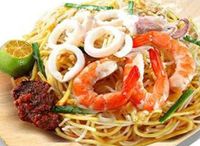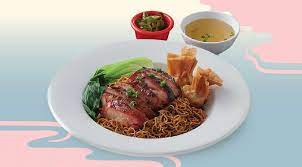Bedok Corner Hokkien Fried Squid Prawn Mee Menu Prices Singapore 2023
Hello Bedok Corner Hokkien Fried Squid Prawn Mee lovers, are you looking for the latest Bedok Corner Hokkien Fried Squid Prawn Mee Menu? You have arrived at the right place then. We have uploaded their complete menu with pictures & updated prices. Below you will find the latest Lists of Bedok Corner Hokkien Fried Squid Prawn Mee Menu 2023 Singapore with prices.

Bedok Corner Hokkien Fried Squid Prawn Mee Menu Singapore With Prices List
Noodle
How much is Hokkien mee in Singapore?
Tiong Bahru Food Centre is home to the renowned Hong Heng Fried Sotong Prawn Mee, a Michelin Bib Gourmand stall since 2016. This family-run stall, now in its third generation, specializes in serving delicious Hokkien Mee cooked in small batches. Priced at $4, $5, and $6 per plate, these flavorful dishes are in high demand, often selling out before their 6pm closing time. The stall’s reputation for mouthwatering flavors and authentic preparation techniques has earned it a loyal following. If you’re a fan of Hokkien Mee, a visit to Hong Heng Fried Sotong Prawn Mee promises a memorable and satisfying culinary experience.
What is the difference between Hokkien Mee and prawn mee?
Prawn Mee, known as 虾面 in Chinese, is a beloved dish with variations across different regions. In Tiong Bahru Food Centre, you’ll find the famous Hong Heng Fried Sotong Prawn Mee stall, holding its Michelin Bib Gourmand status since 2016. Prepared by a third-generation hawker, this Hokkien specialty is cooked in small batches and served in plates priced at $4, $5, and $6. The stall’s authentic flavors attract a loyal following, and the delicious dish frequently sells out before closing at 6pm. While Prawn Mee is also known as Hokkien Mee, Mee Yoke, and Hae Mee in northern Malaysia, it’s essential to note that in central Malaysia, Hokkien Mee refers to a different stir-fry noodle dish, also known as Hokkien Char in Kuala Lumpur.
What is Hokkien prawn mee?
Fried Hokkien Prawn Noodles, commonly known as Hokkien Mee, is a flavorful dish that features thick yellow noodles stir-fried in a delicious prawn and pork broth. Served with a side of chili and lime, this local favorite is beloved for its rich flavors and satisfying taste. The origins of Hokkien Mee are subject to various accounts and stories, adding to its intrigue and cultural significance. As a popular local dish, it continues to captivate both locals and visitors alike, showcasing the diverse and vibrant culinary landscape of the region. Whether you’re a fan of noodle dishes or a food enthusiast exploring local delicacies, Hokkien Mee is a must-try dish on your culinary journey.
How unhealthy is Hokkien Mee?
Healthy Tip: While Fried Hokkien Prawn Noodles (Hokkien Mee) is a delicious dish, it is important to be mindful of its nutritional content. While it is low in energy and fat, it tends to be high in sodium and cholesterol. For individuals with high blood cholesterol and high blood pressure, it is advisable not to consume this dish regularly. To make it healthier, consider reducing the consumption of the gravy, as it can help lower both sodium and cholesterol levels. As with any dish, moderation is key to enjoying the flavors while maintaining a balanced and healthy diet.
What is special about Hokkien mee?
Singapore Hokkien Mee is a delectable dish known for its aromatic broth, created by simmering prawns and pork bones for hours. This slow-cooked broth forms the heart of the dish, infusing the noodles with rich flavors. To elevate the taste, diners are provided with sambal chili and calamansi limes on the side, allowing them to add an extra zing and tanginess to the dish according to their preference. The result is a harmonious blend of flavors that delight the taste buds and make Singapore Hokkien Mee a favorite among locals and visitors alike.
What is the taste of Hokkien mee?
Imagine indulging in a plate of thick, chewy egg noodles enveloped in a luscious glossy sauce that strikes a perfect balance between sweet and salty. Every bite reveals succulent and bouncy prawns complemented by the delightful combination of leafy greens and tender pork belly. The magic behind this flavor profile lies in the dark soy and sweet soy sauce, which infuse the dish with its distinctive dark brown hue and delectable sweet salty taste. Without these two key ingredients, the dish’s signature character would be incomplete, leaving you without that rich, irresistible experience of the beloved noodle dish.

Author: Christopher Tan
Hi there! I’m Christopher Tan, an award-winning writer, cooking instructor, and photographer. My passion lies in combining my love for words, images, and of course, food to create meaningful experiences. I have been honored to have my work published in numerous esteemed publications, including the Sunday Times and Straits Times in Singapore, Saveur magazine in America, and The Peak magazine.
I have expressed my love for food through the written word by authoring and co-authoring multiple cookbooks, including Chinese Heritage Cooking, Ask The Foodie and NerdBaker. I am thrilled to inspire others to create their own meaningful experiences through food, through my writing and teachings. I write restaurant menus and review on eatzeely.com






